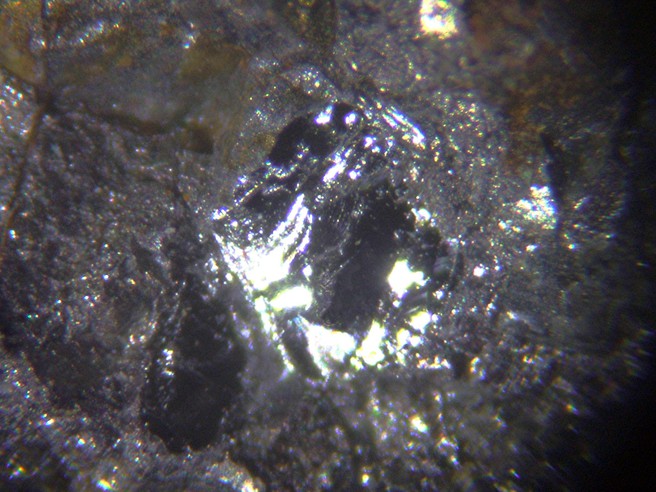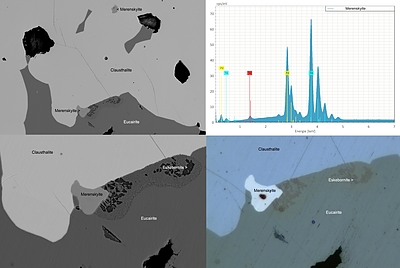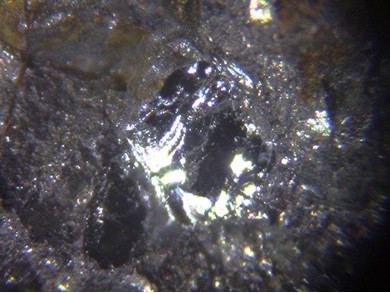The mineralogy of Palladium
| General Properties | |
|---|---|
| Symbol: | Pd |
| Atomic Number: | 46 |
| Standard atomic weight (Ar): | 106.42(1) |
| Electron configuration: | [Kr] 4d10 |
| Photos | ||
|---|---|---|
| < | Palladium crystal | > |
| Atomic Properties | |
|---|---|
| Electronegativity (Pauling scale): | 2.2 |
| Atomic Radius: | 169 pm |
| Ionic Radius: | 59 pm (+1) |
| Van der Waals Radius: | 163 pm |
| 1st Ionization energy: | 804 kJ/mol |
| 1st Electron affinity: | -54 kJ/mol |
| Oxidation States: | 2,4 |
| Physical Properties | |
|---|---|
| Standard State: | solid |
| Bonding Type: | metallic |
| Melting Point: | 1828 K |
| Boiling Point: | 3236 K |
| Density: | 12.02 g/cm3 |
| Metal/Non-Metal: | transition metal |
| Main isotopes of Palladium | ||||
|---|---|---|---|---|
| Isotope | % in Nature | Half Life | Decay type | Decay product |
| 100Pd | synthetic | 3.63d | ε | 100Rh |
| 102Pd | 1.02% | - | β+β+ ? | 102Ru |
| 103Pd | synthetic | 16.991d | ε | 103Rh |
| 104Pd | 11.14% | - | Spontaneous fission ? | |
| 105Pd | 22.33% | - | Spontaneous fission ? | |
| 106Pd | 27.33% | - | Spontaneous fission ? | |
| 107Pd | trace | 6.5×106y | β− | 107Ag |
| 108Pd | 26.46% | - | Spontaneous fission ? | |
| 110Pd | 11.72% | >6×1017y | β-β- | 110Cd |
| Main ions of Palladium | ||||
|---|---|---|---|---|
| Name | Ion | Example minerals | ||
| palladium(II) | Pd2+ | |||
| hexachloropalladate(IV) | [PdCl6]2- | |||
| Other Information | |
|---|---|
| Year Discovered: | 1803 |
| Discovered By: | |
| Year Isolated: | 1803 |
| Isolated By: | William Hyde Wollaston |
| Named For: | after asteroid Pallas |
| CPK color coding: | #006985 |
| External Links: | WikipediaWebElementsLos Alamos National LaboratoryTheodore Gray's PeriodicTable.com |
| Simple Compounds and Mineral Names | |||||||||||||||||||||||||||||||||||||||||||||||||||||||||||||||||||||||||||||||||||||||||||||||||||||||||||||||||||||||||||||||||||||||||||||||||||||||
|---|---|---|---|---|---|---|---|---|---|---|---|---|---|---|---|---|---|---|---|---|---|---|---|---|---|---|---|---|---|---|---|---|---|---|---|---|---|---|---|---|---|---|---|---|---|---|---|---|---|---|---|---|---|---|---|---|---|---|---|---|---|---|---|---|---|---|---|---|---|---|---|---|---|---|---|---|---|---|---|---|---|---|---|---|---|---|---|---|---|---|---|---|---|---|---|---|---|---|---|---|---|---|---|---|---|---|---|---|---|---|---|---|---|---|---|---|---|---|---|---|---|---|---|---|---|---|---|---|---|---|---|---|---|---|---|---|---|---|---|---|---|---|---|---|---|---|---|---|---|---|---|
| Sulfides | palladium sulphide | PdS | +2 | ||||||||||||||||||||||||||||||||||||||||||||||||||||||||||||||||||||||||||||||||||||||||||||||||||||||||||||||||||||||||||||||||||||||||||||||||||||
| palladium disulphide | PdS2 | +4 | |||||||||||||||||||||||||||||||||||||||||||||||||||||||||||||||||||||||||||||||||||||||||||||||||||||||||||||||||||||||||||||||||||||||||||||||||||||
| Selenides | palladium selenide | PdSe | +2 | ||||||||||||||||||||||||||||||||||||||||||||||||||||||||||||||||||||||||||||||||||||||||||||||||||||||||||||||||||||||||||||||||||||||||||||||||||||
| palladium diselenide | PdSe2 | +4 | Verbeekite | ||||||||||||||||||||||||||||||||||||||||||||||||||||||||||||||||||||||||||||||||||||||||||||||||||||||||||||||||||||||||||||||||||||||||||||||||||||
| Tellurides | palladium telluride | PdTe | +2 | ||||||||||||||||||||||||||||||||||||||||||||||||||||||||||||||||||||||||||||||||||||||||||||||||||||||||||||||||||||||||||||||||||||||||||||||||||||
| palladium ditelluride | PdTe2 | +4 | |||||||||||||||||||||||||||||||||||||||||||||||||||||||||||||||||||||||||||||||||||||||||||||||||||||||||||||||||||||||||||||||||||||||||||||||||||||
| Fluorides | palladium difluoride | PdF2 | +2 | ||||||||||||||||||||||||||||||||||||||||||||||||||||||||||||||||||||||||||||||||||||||||||||||||||||||||||||||||||||||||||||||||||||||||||||||||||||
| palladium tetrafluoride | PdF4 | +4 | |||||||||||||||||||||||||||||||||||||||||||||||||||||||||||||||||||||||||||||||||||||||||||||||||||||||||||||||||||||||||||||||||||||||||||||||||||||
| Chlorides | palladium dichloride | PdCl2 | +2 | ||||||||||||||||||||||||||||||||||||||||||||||||||||||||||||||||||||||||||||||||||||||||||||||||||||||||||||||||||||||||||||||||||||||||||||||||||||
| Iodides | palladium diiodide | PdI2 | +2 | ||||||||||||||||||||||||||||||||||||||||||||||||||||||||||||||||||||||||||||||||||||||||||||||||||||||||||||||||||||||||||||||||||||||||||||||||||||
| Oxides | palladium oxide | PdO | +2 | ||||||||||||||||||||||||||||||||||||||||||||||||||||||||||||||||||||||||||||||||||||||||||||||||||||||||||||||||||||||||||||||||||||||||||||||||||||
| palladium dioxide | PdO2 | +4 | |||||||||||||||||||||||||||||||||||||||||||||||||||||||||||||||||||||||||||||||||||||||||||||||||||||||||||||||||||||||||||||||||||||||||||||||||||||
| Mineral Diversity of Palladium | |
|---|---|
| 1. Elements | 18 valid mineral species |
| 2. Sulfides And Sulfosalts | 62 valid mineral species |
| 4. Oxides | 1 valid mineral species |
| Total: | 81 valid species containing essential Palladium |
| Geochemistry of Palladium | |
|---|---|
| Goldschmidt classification: | Siderophile |
| Elemental Abundance for Palladium | ||
|---|---|---|
| Crust (CRC Handbook) | 1.5 x 10-8 | mass fraction, kg/kg |
| Crust (Kaye & Laby) | 3 x 10-9 | mass fraction, kg/kg |
| Crust (Greenwood) | 1.5 x 10-8 | mass fraction, kg/kg |
| Crust (Ahrens/Taylor) | 1.0 x 10-9 | mass fraction, kg/kg |
| Upper Crust (Ahrens/Taylor) | 5 x 10-10 | mass fraction, kg/kg |
| The Sun (Kaye & Laby) | 1.4 x 10-6 | atom mole fraction relative to Si=1 |
| Solar System (Kaye & Laby) | 1.4 x 10-6 | atom mole fraction relative to Si=1 |
| Solar System (Ahrens) | 1.39 x 10-6 (6.6%) | atom mole fraction relative to Si=1 (% uncertainty) |
| Element association of Palladium in the Mineral World | |||
|---|---|---|---|
| This table compares the known valid mineral species listed listed with Palladium and the other elements listed based on the official IMA formula. Note that unlike other sections on this page this includes non-essential elements. The first data column contains the total number of minerals listed with Palladium and the element listed for that row. The second data column lists this number as a percentage of all minerals listed with Palladium. The final data column compares this percentage against the percentage of all minerals that contain the element listed in each row. Click on a heading to sort. |
| Periodic Table | |||||||||||||||||||||||||||||||||||||||||||||||||||||||||||||||||||||||||||||||||||||||||||||||||||||||||||||||||||||||||||||||||||||||||||||||||||||||
|---|---|---|---|---|---|---|---|---|---|---|---|---|---|---|---|---|---|---|---|---|---|---|---|---|---|---|---|---|---|---|---|---|---|---|---|---|---|---|---|---|---|---|---|---|---|---|---|---|---|---|---|---|---|---|---|---|---|---|---|---|---|---|---|---|---|---|---|---|---|---|---|---|---|---|---|---|---|---|---|---|---|---|---|---|---|---|---|---|---|---|---|---|---|---|---|---|---|---|---|---|---|---|---|---|---|---|---|---|---|---|---|---|---|---|---|---|---|---|---|---|---|---|---|---|---|---|---|---|---|---|---|---|---|---|---|---|---|---|---|---|---|---|---|---|---|---|---|---|---|---|---|
| |||||||||||||||||||||||||||||||||||||||||||||||||||||||||||||||||||||||||||||||||||||||||||||||||||||||||||||||||||||||||||||||||||||||||||||||||||||||
| Rhodium << Palladium >> Silver | |||||||||||||||||||||||||||||||||||||||||||||||||||||||||||||||||||||||||||||||||||||||||||||||||||||||||||||||||||||||||||||||||||||||||||||||||||||||
| Most widespread minerals containing Palladium | |||
|---|---|---|---|
| This list of minerals containing Palladium is built from the mindat.org locality database. This is based on the number of localities entered for mineral species and is therefore slanted towards minerals interesting to collectors with less coverage of common rock-forming-minerals so it does not give an undistorted distribution of Palladium mineral species. It is more useful when comparing rare species rather than common species. |
| Name | Formula | Crystal System | Mindat Localities |
|---|---|---|---|
| Merenskyite | PdTe2 | Trigonal | 210 |
| Kotulskite | Pd(Te,Bi)2-x (x ≈ 0.4) | Hexagonal | 179 |
| Michenerite | PdBiTe | Isometric | 166 |
| Braggite | PdPt3S4 | Tetragonal | 159 |
| Stibiopalladinite | Pd5Sb2 | Hexagonal | 112 |
| Vysotskite | PdS | Tetragonal | 94 |
| Mertieite | Pd8Sb2.5As0.5 | Trigonal | 89 |
| Froodite | α-PdBi2 | Monoclinic | 84 |
| Sobolevskite | PdBi | Hexagonal | 78 |
| Palladium | (Pd,Pt) | Isometric | 78 |
| Photos |
|---|
Spotted a mistake/omission? - These pages are a work in progress, so please send all comments/corrections to jolyon@mindat.org. Thank you.
Constants and physical property data from:
David R. Lide (ed.), CRC Handbook of Chemistry and Physics, 85th Edition. CRC Press. Boca Raton, Florida (2005).
Kaye and Laby Tables of Physical & Chemical Constants (2005). Section 3.1.3, Abundances of the elements
A. Earnshaw, N. Greenwood, Chemistry of the Elements, 2nd edition, Butterworth-Heinemann, (1997)
Thomas J. Ahrens (ed.), Global Earth Physics : A Handbook of Physical Constants, American Geophysical Union (1995)
L.B. Railsback, An Earth Scientist's Periodic Table of the Elements and Their Ions : Geology 31:9 p737-740 (2003)
Emsley, J. Nature's Building Blocks: An A-Z Guide to the Elements. New York: Oxford University Press (2001)


















